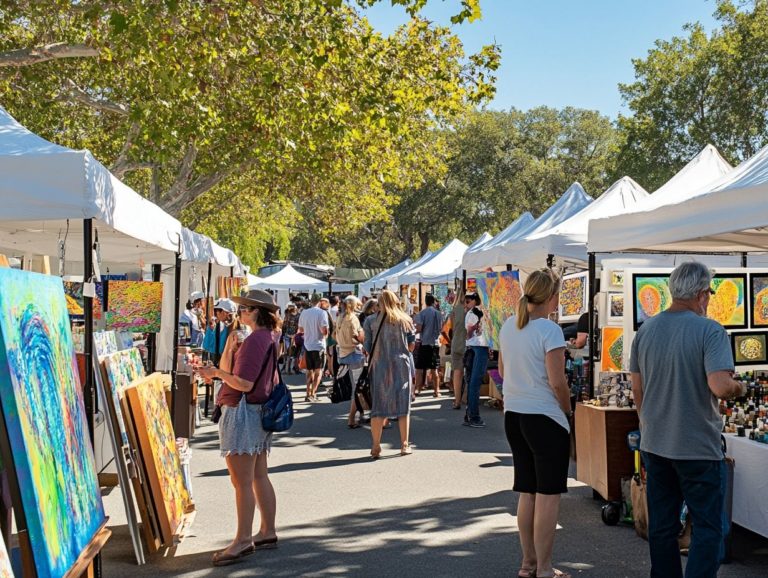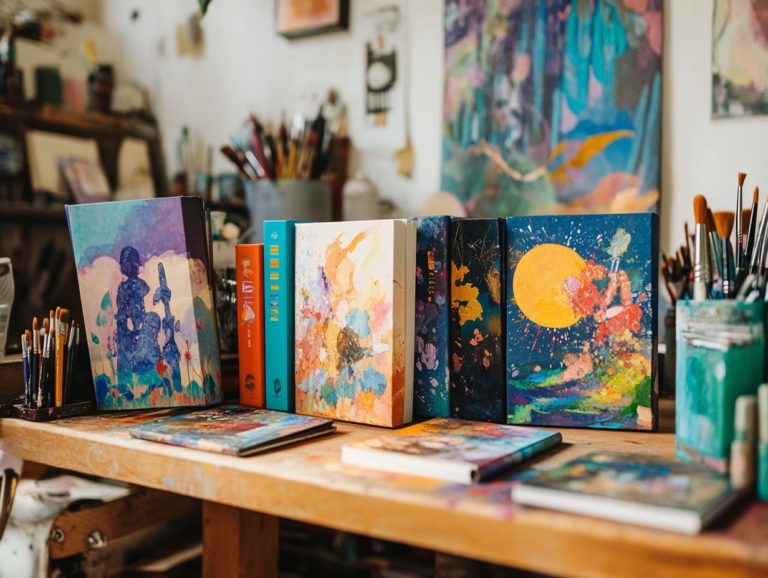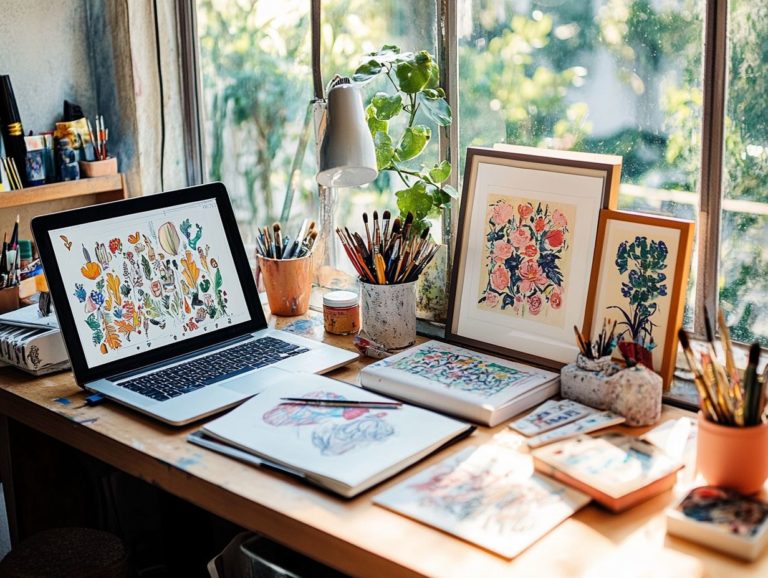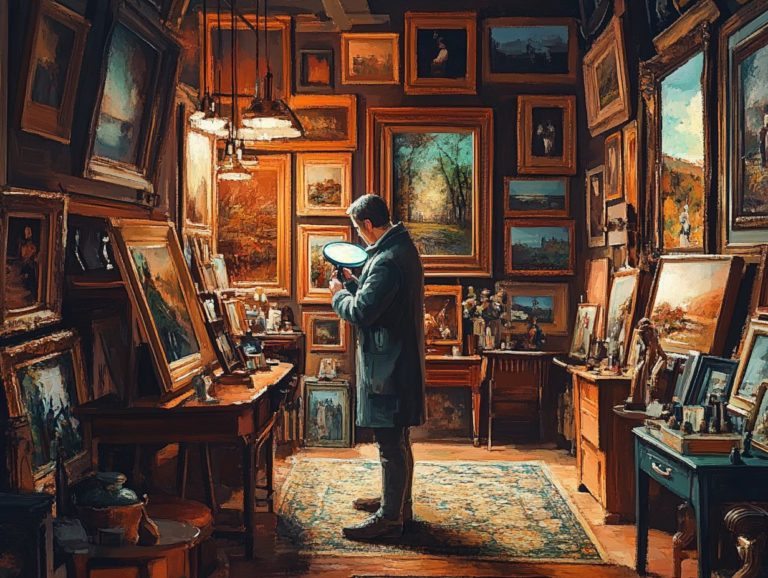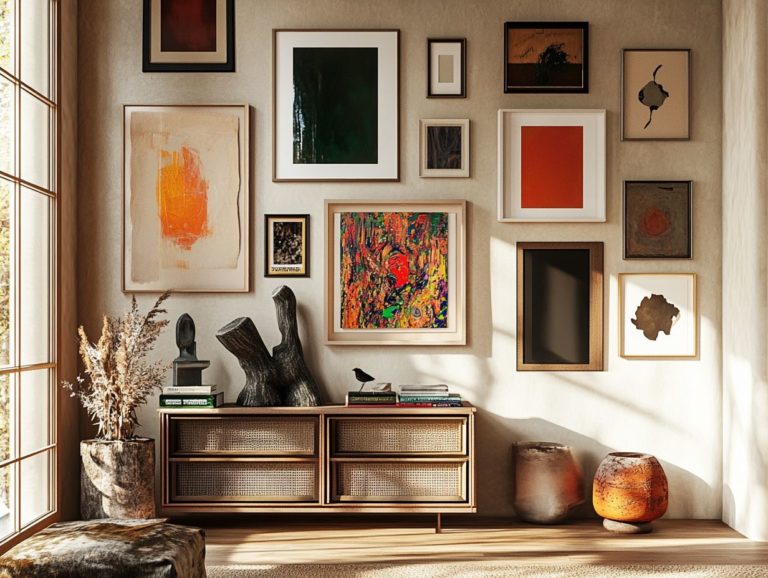Art Auctions: The Collector’s Buying Guide
Art auctions provide an exciting opportunity for seasoned collectors and first-time buyers alike. You can acquire unique pieces that often hold significant value.
This article explores the benefits of buying art at auctions. You ll learn how to access exclusive works and discover fantastic deals.
Discover essential steps for successful bidding. Familiarize yourself with key terms and strategies to navigate the auction landscape confidently.
Whether you want to invest or enhance your collection, this guide prepares you for a rewarding experience.
Contents
Key Takeaways:

Art auctions offer unique opportunities for collectors. You can access rare, high-quality pieces at potentially lower prices.
To buy art successfully at auctions, thorough research and preparation are essential. Get familiar with key terms and the auction process to avoid common mistakes.
What are Art Auctions?
Art auctions are lively events where the excitement of bidding unfolds. Here, artworks, antiques, and collectibles are sold to the highest bidder.
Prestigious auction houses like Sotheby s and Christie s host these events. They bring together collectors and enthusiasts driven by emotional connections to the pieces on display.
As you bid, you’ll experience a thrilling atmosphere. Final prices can soar far beyond estimated values!
Items commonly up for grabs include:
- Valuable original paintings
- Rare sculptures
- Exquisite jewelry
- Notable antiques
Each item is carefully evaluated, with bidding increments designed to heighten excitement among participants. Condition reports keep you informed, ensuring transparency in transactions.
Benefits of Buying Art at Auctions
Buying art at auctions offers unique advantages that elevate your experience. This exciting avenue appeals to both seasoned collectors and newcomers.
Auctions provide access to a diverse range of collectibles, from fine art to antiques. You can acquire pieces that truly resonate with your aesthetic.
They also promote transparency with detailed condition reports. This expert insight helps guide your purchasing decisions.
Unique Opportunities and Advantages
Art auctions offer you a distinctive chance to acquire exceptional pieces that may not be found through traditional retail channels. Often, you can find these pieces at competitive and transparent prices.
You can explore a variety of artworks, from contemporary talents like Christopher Wool to classical gems by Paul Mellon. This ensures a diverse selection tailored to your unique tastes.
The dynamic environment of competitive bidding can drive prices higher. As a savvy collector, leverage your understanding of the pricing structure to identify potential bargains.
These auctions frequently grant you exclusive access to artworks tucked away in private collections. This allows you to witness the history and artistry behind each piece.
Engaging with renowned auction houses opens the door to rare acquisitions and allows you to network with fellow collectors and industry insiders. These connections can be invaluable.
Here are some effective strategies to enhance your auction experience:
- Set a clear budget.
- Participate in pre-auction previews to gauge interest in specific pieces.
- Study past auction results to decipher bidding trends.
Understanding the motivations of your fellow bidders can also give you an edge. This lets you navigate the competitive landscape with greater confidence.
Steps to Successfully Buy Art at Auctions

Embarking on the journey to successfully purchase art at auctions demands meticulous planning and strategic execution. This equips you to navigate the intricacies of the auction process with confidence.
Grasping the essential steps from looking into auction catalogues and condition histories to refining your bidding strategies enables you to make informed choices. This optimizes your investment potential.
By employing research guidelines, you gain insight into sales trends and auction results. This paves the way for a truly rewarding purchasing experience.
Researching and Preparing for an Auction
Researching and preparing for an art auction is essential for your success in acquiring valuable pieces. It requires a thorough understanding of the auction market and relevant auction houses.
As a potential bidder, immerse yourself in resources like price databases and condition reports. Seek expert advice to evaluate artworks accurately and align your expectations with current market trends.
Reviewing auction catalogues offers invaluable insights into significant pieces available. This helps you familiarize yourself with the auction’s lineup and historical price records.
To elevate your preparation, consider leveraging analytical tools that provide historical performance data tied to specific artists or styles. This can illuminate emerging trends.
Learning to interpret key metrics, such as estimated values and the amount by which bids increase, along with understanding auction house fees, enables you to make informed decisions.
A thorough examination of past auctions reveals bidding behaviors, equipping you with a strategic edge. This groundwork enhances your confidence and maximizes your chances of securing coveted artworks.
Bidding and Winning Strategies
Mastering bidding and winning strategies is your ticket to success as a collector in the competitive realm of art auctions. For those looking to navigate this thrilling landscape, understanding the art market is essential, as excitement is palpable and the stakes are high.
Understanding the mechanics of bidding increments is key. They dictate how bids escalate and directly influence your purchasing journey.
A well-considered approach, combined with awareness of the auction atmosphere and strategic timing, enables you to make confident bids. This enhances your chances of securing coveted artworks.
By keeping a close eye on the increments, you can gauge fellow bidders’ behaviors. This helps you make informed choices about when to bid aggressively or hold back.
Emotions can run high in these exhilarating settings, so it’s crucial to stay grounded. Avoid impulsive reactions.
A successful strategy involves pinpointing the right moment to advance your bid, especially when competition heats up. Recognize when to step back to prevent financial overreach.
Striking this balance leads to a more satisfying and advantageous experience, ensuring your decisions are both emotionally fulfilling and financially sound.
Understanding the Auction Process
Understanding the auction process is essential for anyone aiming to navigate the art auction landscape with finesse. This journey involves a sequence of steps designed to ensure both transparency and excitement in bidding.
From the moment auction houses begin their preparations complete with meticulously crafted auction catalogues and comprehensive condition reports to the exhilarating moment of the final hammer drop that signifies a winning bid, each phase reveals valuable insights into auction etiquette and expected outcomes.
By familiarizing yourself with this process, you will not only elevate your buying experience but also enable yourself to make informed decisions grounded in the wisdom of past auction results.
Key Terms and Concepts to Know
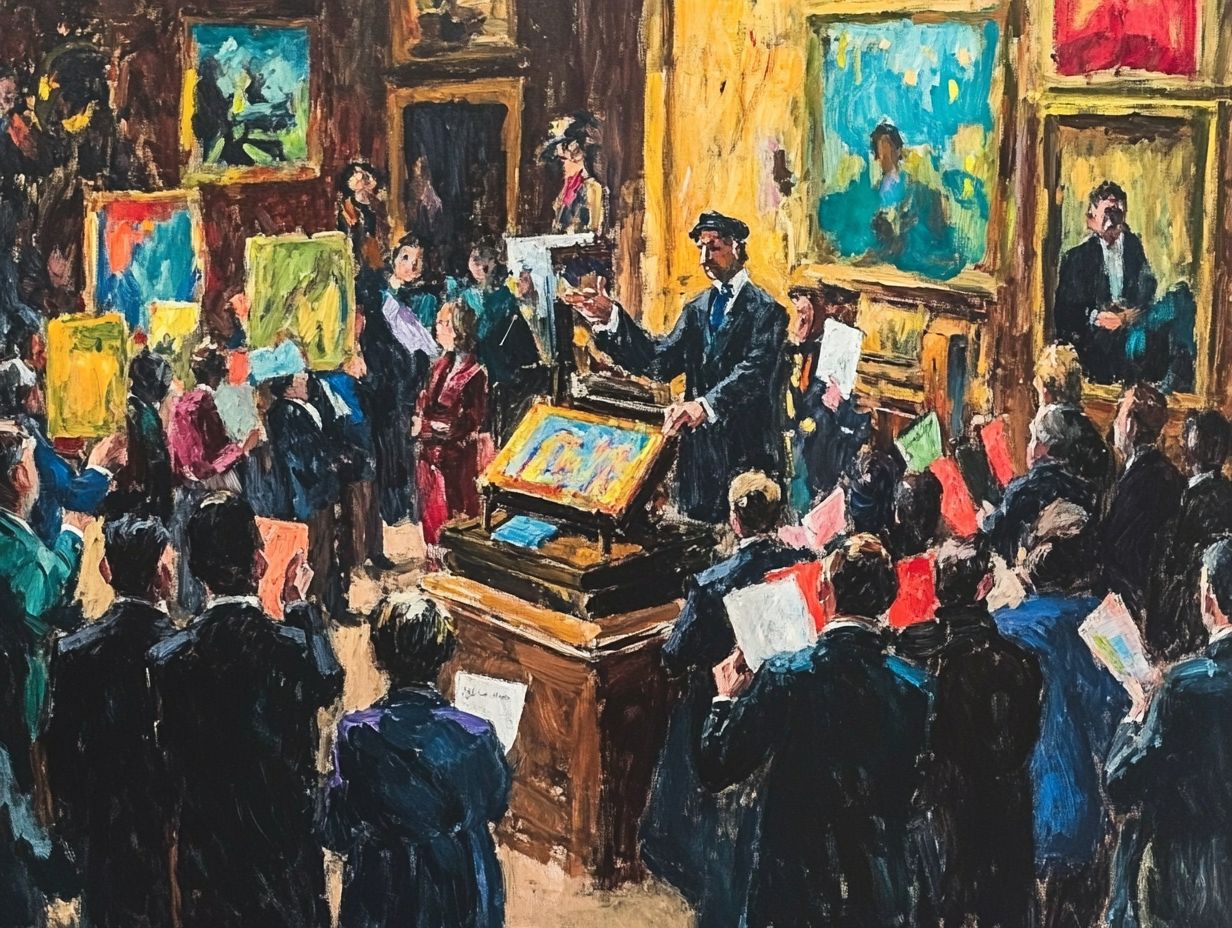
Familiarizing yourself with key terms related to art auctions is essential for any potential buyer. This knowledge lays the groundwork for informed participation in the auction market.
Understanding the background history of an artwork allows you to ascertain its authenticity and value.
Grasping the lowest price a seller will accept helps you avoid inadvertently overpaying.
Being aware of the additional percentage added to the winning bid enables you to make comprehensive financial evaluations.
Collectively, these concepts equip you with the necessary knowledge to navigate the intricacies of auctions, enhancing your chances of securing valuable pieces without falling victim to common pitfalls.
Tips for First-Time Art Auction Buyers
As a first-time art auction buyer, stepping into this dynamic environment can feel both exhilarating and intimidating. Yet, with the right knowledge and preparation, you can transform this experience into something truly rewarding.
Grasping auction strategies like setting a budget and understanding the emotional impact of different artworks will help you navigate the often overwhelming process. It’s also wise to seek insights on art appraisal, further enhancing your confidence and decision-making as you embark on this exciting journey.
Common Mistakes to Avoid
Avoiding common mistakes is essential for you as a first-time buyer at art auctions. Missteps can lead to regrettable purchases or missed opportunities, ultimately tarnishing your overall experience.
If you come unprepared such as not using a price database or failing to grasp bidding strategies you risk making less-than-optimal decisions. Ignoring auction etiquette and the social nuances of the bidding environment can shake your confidence, leading to impulsive purchases that might not align with your long-term art investment goals.
To ensure a smoother experience, prioritize thorough research before attending an auction. Familiarize yourself with the lots, artists, and their past sale prices.
Learn about paddle numbers and bid increments to boost your participation. Seeking advice from seasoned collectors or industry professionals can provide you with invaluable insights.
By recognizing and sidestepping common pitfalls, you can develop a strategic approach that enables you to make informed choices. This not only enriches your collection but also fosters a rewarding relationship with the art community.
Frequently Asked Questions
1. What is the purpose of an art auction?
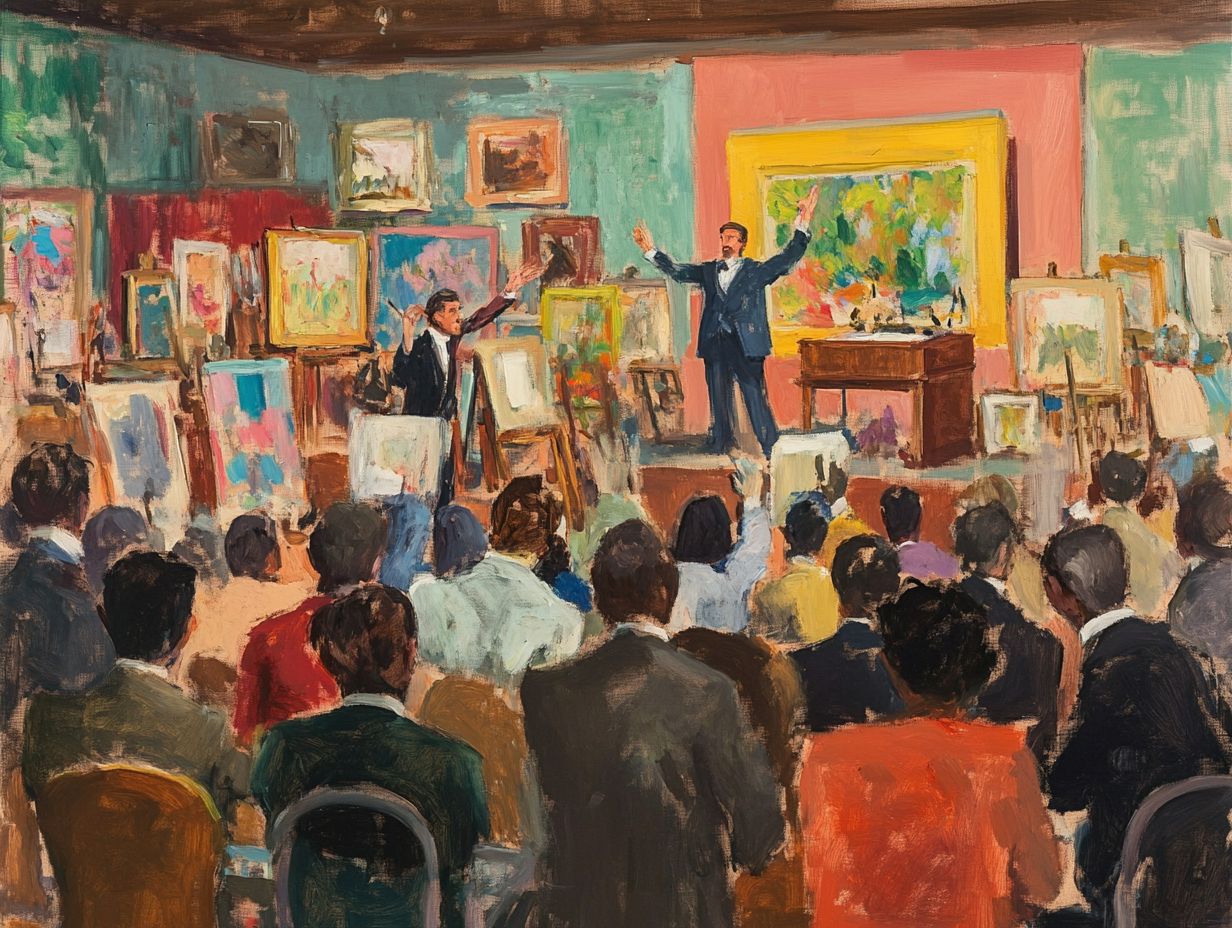
An art auction is a public event where pieces of art are sold to the highest bidder. The purpose is to facilitate the buying and selling of valuable artwork and to establish the current market value of these pieces.
2. How can I prepare for an art auction as a collector?
As a collector, it’s important to research the pieces and artists being featured in the auction beforehand. This preparation will help you make informed decisions and set a budget for your purchases, especially when it comes to collecting limited edition prints.
3. Are all art auctions the same?
No, art auctions can vary in size, location, and types of artwork being sold. Some may specialize in a particular style or era, while others may feature a variety of genres. It’s important to research the specific auction you are interested in attending.
Ready to dive into the world of art auctions? Check out upcoming events now!
4. What factors should I consider when buying art at an auction?
When buying art at an auction, consider the piece’s condition and its history. Also, check the current market value and remember to include any extra fees, like the buyer’s premium, in your budget.
5. Can I negotiate the price at an auction?
The price at an art auction usually comes from competitive bidding. Some auctions may allow negotiation if a piece doesn t hit its reserve price, so check the auction’s rules first.
6. What should I do after buying art at an auction?
Once you purchase art, get a receipt or invoice as proof. Make sure to insure your new piece and have it appraised by a professional for authenticity and market value.

